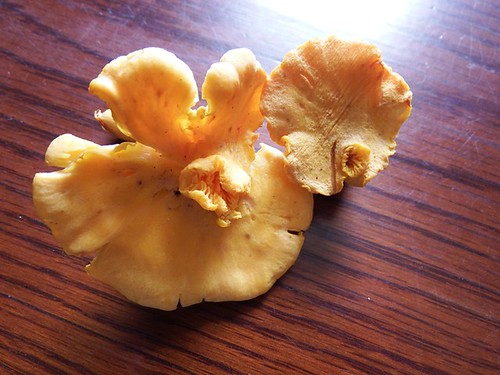|
|
Post by ayjay on Oct 26, 2015 23:00:15 GMT
A couple of years ago, I was walking through a coniferous part of a local wood, I diverted off the main path and came across a fungi which was Banana yellow in colour and looked a lot like a piece of coral - subsequent investigation leads me to think it was was a Yellow Stag's Horn Fungus - I had no camera with me at the time and I never managed to get back to take a pic. Yesterday I thought I'd take a look and see if it was growing there again, but unfortunately I couldn't find it. What I did find was in the pics below - at first glance I thought a tiny Mushroom had been placed on top of a larger one, but they have actually grown together. Is this a common occurrence?  IMG_8988-c-r IMG_8988-c-r by Wabi Gallery, on Flickr  IMG_8990-c-r IMG_8990-c-r by Wabi Gallery, on Flickr |
|
|
|
Post by ayjay on Jul 26, 2016 12:01:48 GMT
Just dragging this back to the top, in the hope that any newer members can maybe shed some light.
|
|
|
|
Post by rowanberry on Jul 26, 2016 21:05:38 GMT
I have to say I've never seen anything like this... I think you're right in thinking that two have grown together. Could a spore have landed on the developing cap of the larger one and then it grew from there? Although it looks upside-down...maybe a bird or squirrel dropped it onto the damp cap and they merged.
I did a google, and found this page on 'conjoined food'...there's a few of mushrooms on it, although they've merged from side by side.
....actually, I can't get the link to work.
If you do a search in Google images for 'Flickr conjoined mushrooms' quite a few come up.
|
|
|
|
Post by ayjay on Jul 26, 2016 22:18:54 GMT
I did google that and I have to say I've seen the side by side merged ones before (I've eaten some too),but the little one upside down and on top has me puzzled. The small one has obviously not grown once it has lost contact with ground, I can only assume that the larger one just grew from underneath it before it had a chance to grow itself.
|
|
|
|
Post by Cotham Marble on Jul 28, 2016 9:08:21 GMT
I did google that and I have to say I've seen the side by side merged ones before (I've eaten some too),but the little one upside down and on top has me puzzled. The small one has obviously not grown once it has lost contact with ground, I can only assume that the larger one just grew from underneath it before it had a chance to grow itself. I think that's the right explantion. Your picture shows what must be fruiting bodies of the same mycelial colony - I don't recognise the species but they look to be identical caps rather than being a fortuitous growth of one species on another or a parasitic species. Whether there is transfer of nutrient when fruiting bodies are joined like this I don't know but given the structure of fruiting bodies that does seem plausible, so in this case while the stalk of the smaller cap became disconected as the larger one grew, the smaller one may not have been wholly deprived of moisture and continued to function as a fruiting body if somewhat dwarfed. |
|
|
|
Post by NellyDee on Aug 2, 2016 8:28:51 GMT
Just as a bye the bye I see this quite a bit with Chanterelles, especially where growing confined to a steep mossy slopes, This photo shows two but there are many with bumps that look like the start of this type of growth
 Chanterelle with added growth by Helen Skelton, on Flickr Chanterelle with added growth by Helen Skelton, on Flickr
|
|
|
|
Post by Cotham Marble on Aug 3, 2016 9:24:25 GMT
|
|
|
|
Post by NellyDee on Aug 3, 2016 15:39:32 GMT
Weighty but interesting - will take me a while to read it all.
|
|
|
|
Post by ayjay on Aug 3, 2016 21:13:18 GMT
Weighty but interesting - will take me a while to read it all. Me too! ....but thanks for the effort CM. |
|